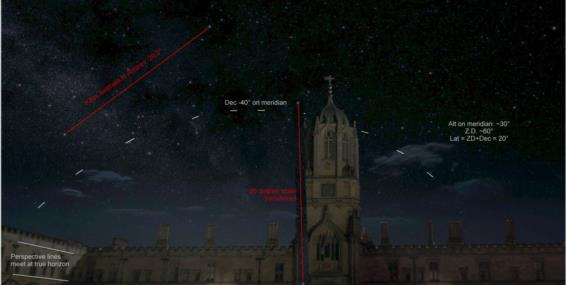
NavList:
A Community Devoted to the Preservation and Practice of Celestial Navigation and Other Methods of Traditional Wayfinding
From: Frank Reed
Date: 2024 Apr 14, 16:50 -0700
"Assuming Mr Scorpion to be due south - which looks a reasonable starting point here when seen from the northern hemisphere - and with its southmost star somewhere around 20° over the local horizon, maximum Latitude cannot be much further north than about 40°N."
My thought when I saw the tail of the scorpion in this view while watching the episode was a little different. First, it has to be well below 40°N because the tail is never that high around here (I'm near 41°). Also, it's tilted. I have long seen the lower edge of the scorpion's tail on star charts, and it runs parallel to a circle of Declination. That it is tilted would seem to imply that it is some distance away from the meridian.
I didn't really give this image any further thought until this morning. I previously mentioned that the magnitude limit is improbably deep, and also suggested that the foreground is probably "wrong", but that's no surprise for a pop culture production. To analyze it "astronomically", I decided to expand on my initial impression that the scorpion's tail is tilted. So I traced along the image, comparing against star charts --both the exquisite paper charts in "Sky & Telescope's Pocket Sky Atlas" (created by occasional NavList contributor Roger Sinnott) and also the digital sky in "Stellarium". Without being too careful, since, after all, we know it's only a simulated sky, I looked for recognizable star patterns and traced along the circle of -40° Dec with short lines marked (see my modified image attached). The peak of this curve must lie on the meridian, and its maximum altitude is naturally a measure of the implied latitude. As you can see in my image, the peak appears to be somewhat to the left of the tower at Tom Quad. Thus the sky is oriented approximately a dozen degrees to the right of due south.
Let's kill the foreground first. You can visit this location at Oxford in Google Maps (including Streetview images inside the quad) and to see the tower as shown in the image as displayed, you're facing west, not south. So, in case there was any lingering doubt, that's the simple evidence that this is a digital "collage". Nonetheless, if we treat it as an attempt to produce a semi-realistic sky, the foreground serves one other purpose. It has perspective lines, and those perspective lines will converge at the true horizon. I didn't bother doing a detailed analysis here, but I'll say that the two most readily visible lines converge somewhat below frame.
I estimate that the altitude of the peak of the curve of Dec -40° is about 30° above the implied true horizon, using the angular distance from Kaus Australis (a prominent "teapot" star) to Antares as a yard stick. Next we can apply the standard relationship for any standard meridian sight (any except a "below the pole" sight, but otherwise any meridian sight including that most fundamental case, Noon Sun):
Lat = ZD + Dec.
The ZD (zenith distance) here is about 60° for a Dec of -40° so the observer's latitude implied by the image is around +20°. And that's a long way from Oxford!
Incidentally, I have a guess that this image was produced in a particular type of digital planetarium. If you zoom in one step on the Milky Way star clouds in Sagittarius, to the left of Scorpius, you'll see that they're "speckled", not a hazy "cloud" of stars like in most other simulations, but actually a mass of rather arbitrary faint "star" images. This became a popular method of producing a Milky Way effect in planetarium displays a couple of decades ago. By using star images too faint to see individually, a realistic "scintillation" of the Milky Way was produced. I think that's what we're seeing here...
Finally, just a comment: the image illustrates that artists (and probably viewers of the program) can no longer imagine darkness. The buildings in the quad are clearly brightly illuminated and from two different sources, but that seems "normal" now. If we could really kill all the lights at Oxford to see a sky full of stars like this, the buildings would be dark as pitch, ghostly shadows in front of the glowing background of stars.
Frank Reed







